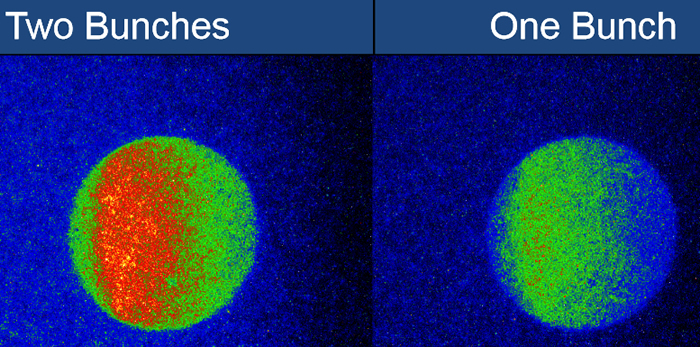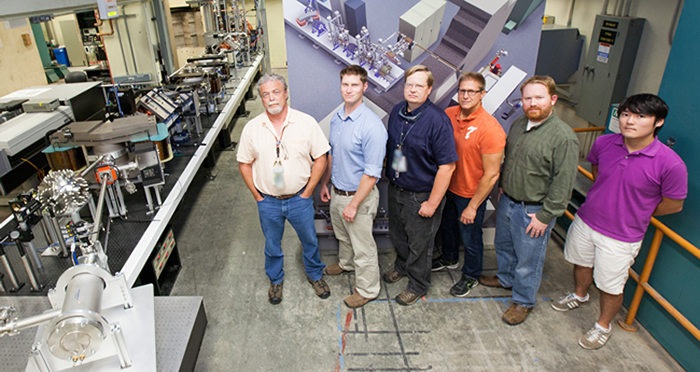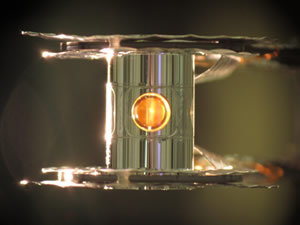Science & Technology - 2015
January
NIF Fuel Gain Named a “Top Breakthrough” of 2014
First Laser-Compton X Rays Produced
LLNL’s laser-Compton light source system has produced its first x-ray light, at about 30 keV (30,000 electron volts). The system is based on an X-band (11.424 GHz) photoinjector, a type of high-brightness electron beam source, and is designed to produce up to 50 MeV (million-electron-volt) electron bunches for the laser-Compton system.
“While the machine setup is still very far from optimized,” said NIF & Photon Science Chief Technology Officer Chris Barty, “I believe this is the first time a compact X-band accelerator has been used to produce Compton photons.” He said the 30-keV x rays could be used for medical imaging, NIF target metrology, and dynamic studies of high energy density materials.
“Of even more significance,” Barty said, “after seeing x rays, the setup was changed to operate in two-bunch mode. This was done by modifying the UV (ultraviolet) illumination of the photo-cathode to produce two approximately equal-charge electron bunches spaced one RF (radio frequency) period (87.5 picoseconds) apart (see “First Multi-bunch Operation from a Compact X-band Accelerator”). After acceleration, the two bunches interacted with one long-duration green laser pulse to double the Compton x-ray output.
 Comparison of the Compton x-ray flux from one-bunch (right) and two-bunch photoinjector beams. The round region on the detector image is defined by the aperture through which the x rays emerge from the system. The counts in this region are summed and the background is subtracted to provide an estimate of the total Compton-scattered photons. The sum of individual single-bunch outputs is approximately equal to the output from two-bunch operation.
Comparison of the Compton x-ray flux from one-bunch (right) and two-bunch photoinjector beams. The round region on the detector image is defined by the aperture through which the x rays emerge from the system. The counts in this region are summed and the background is subtracted to provide an estimate of the total Compton-scattered photons. The sum of individual single-bunch outputs is approximately equal to the output from two-bunch operation. “To my knowledge, this is the first time that multi-bunch laser-Compton operation has been demonstrated,” he said. “Relative to traditional laser-Compton architectures, this mode of operation is simpler, potentially produces narrower bandwidth output, and can be scaled to much higher flux by operating the accelerator with even more micro bunches per RF macro pulse.”
Laser-Compton systems are a new class of light source created by Compton scattering short-duration laser pulses from relativistic (moving at close to the speed of light) electrons. The peak brightness of a laser-Compton pulse can be 15 orders of magnitude beyond any other man-made light in the MeV spectral range. The technology enables production of mono-energetic gamma rays and x rays; in the gamma-ray regime, these sources can be used in new, isotope-specific nuclear materials detection systems and photon-based study of nuclear processes, a field known as nuclear photonics.
 In the laser-Compton light source device, electrons and laser photons crash head-on, creating a backscatter of gamma rays that is one million times more powerful than the incoming photons (Rendering by Kwei-Yu Chu).
In the laser-Compton light source device, electrons and laser photons crash head-on, creating a backscatter of gamma rays that is one million times more powerful than the incoming photons (Rendering by Kwei-Yu Chu). The X-band photoinjector was developed by a collaboration between NIF & Photon Science and the Laboratory’s Physical and Life Sciences Directorate and the SLAC National Accelerator Laboratory. The Laser-Compton Experimental Team is led by Roark Marsh and David Gibson and includes Scott Anderson, Gerry Anderson, Scott Fisher, and Shawn Betts.
The use of X-band power, instead of the S-band (2.856-GHz) power now used in many accelerators, enables the accelerator system to produce higher-energy electrons with greater accuracy in a shorter distance; the new accelerator will reduce the size of the laser-Compton light source. Barty said the current equipment could be upgraded by adding additional X-band accelerator sections and RF power to produce mono-energetic gamma rays, making possible a portable gamma-ray source and detector that can be used to detect nuclear isotopes for basic science, homeland security, and other applications.
 Members of the Laser-Compton Team next to the X-band accelerator (from left): Gerry Anderson (Physics and Life Sciences), Roark Marsh (NIF&PS), Scott Anderson (PLS), Shawn Betts (NIF&PS), David Gibson (NIF&PS), and Yoonwoo Hwang (UC Irvine summer student).
Members of the Laser-Compton Team next to the X-band accelerator (from left): Gerry Anderson (Physics and Life Sciences), Roark Marsh (NIF&PS), Scott Anderson (PLS), Shawn Betts (NIF&PS), David Gibson (NIF&PS), and Yoonwoo Hwang (UC Irvine summer student). NIF Fuel Gain Named a ‘Top Breakthrough’ of 2014
Physics World, an international monthly magazine published by the Institute of Physics, has named NIF’s achievement of fuel gain one of its top 10 “Breakthroughs of the Year.” The achievement also was ranked No. 13 on Discover Magazine’s list of the top 100 science stories of 2014 and was cited as one of the top 10 physics news stories of 2014 by APS News, the American Physical Society’s online news site. 
Ignition—the process of releasing fusion energy equal to or greater than the amount of energy used to confine the fuel—has long been considered the “holy grail” of inertial confinement fusion science. Before achieving ignition, a key step along the path is to have “fuel gains” greater than unity, where the energy generated through fusion reactions exceeds the amount of energy deposited into the fusion fuel and alpha-particle self-heating of the fusing region.
NIF—the world’s largest and highest-energy laser—was the first facility to reach the milestone of achieving fuel gains greater than one with significant levels of alpha heating. In a paper published in the Feb. 12 online issue of the journal Nature, scientists detailed a series of experiments conducted on NIF which showed an order of magnitude improvement in yield performance over previous experiments.
 A NIF inertial confinement fusion target.
A NIF inertial confinement fusion target. “Creating the conditions for sustained nuclear fusion to occur in the laboratory has proven notoriously challenging, but persevering is essential because success could lead to safe and clean sources of energy,” said Hamish Johnston, editor of physicsworld.com. “By obtaining a fuel gain of greater than one, the team working at the National Ignition Facility has taken an important step towards realizing fusion energy.”
The Physics World editorial team recognized the achievements from 2014 in a range of topics from nuclear physics to nanotechnology. The top 10 breakthroughs were selected using the following criteria: fundamental importance of research; significant advance in knowledge; strong connection between theory and experiment; and general interest to all physicists.
Discover’s 100 top stories of 2014 was a list of “the best in science from the past year.” The article on the NIF accomplishment said the research is a “crucial milestone toward tapping the power of lab-made fusion.”




